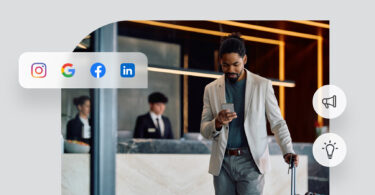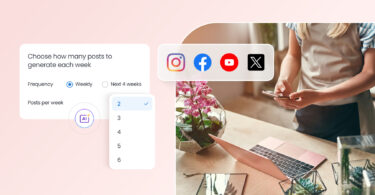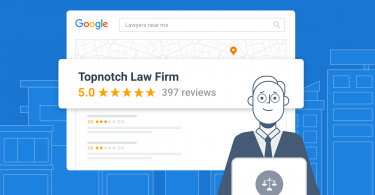Understanding social media algorithms can be the difference between success and failure. Knowing how algorithms operate on each platform is a surefire way to make sure your content reaches your target audience – in theory. Unfortunately, achieving high engagement rates with ever-changing algorithms can be challenging.
In this article, we’ll teach you everything you need to know about the most well-known social media algorithms and explore ways to help your company rank.
Table of contents
What are social media algorithms?
Simply put, social media algorithms are rules that sort posts in your followers’ feeds based on relevancy instead of publish time. In other words, algorithms prioritize posts users want to see and are most likely to engage with.
Before algorithms, social media users would see content in chronological order – regardless of who posted it or whether it was relevant to their interests. As social media became more popular, a constant stream of content followed. Without a well-planned, organized algorithm, users might become overwhelmed with the amount of content they’re presented with.
Today, thanks to algorithms, social media feeds are tailored to the individual follower’s interests. That’s why your followers might see posts about your products and services while their friends might see completely different content. Because of social media algorithms, no two social feeds are alike.
[Free Guide] The ultimate social media marketing guide for local businesses
Download Now
How do social media algorithms work?
Social algorithms are designed to filter content based on your followers’ particular interests using ranking signals. Ranking signals tell the algorithm whether a piece of content is relevant to you based on your previous activity on the app. It’s a form of machine learning – a type of artificial intelligence that enables computers to learn from data and recognize patterns without requiring explicit programming. When the algorithm shows you content that it thinks is relevant to you, it relies on machine learning bias, also called a social media algorithm bias.
By remembering what kind of content your followers engage with most often, the algorithm can determine if a new piece of your content will interest your audience. Then, it can signal that post as relevant and decide where to rank it in its feed.
The more someone uses a social media platform, the more its algorithm will learn about their behavior and content preferences. For example, if your company is in the sports industry, your content will most likely reach the feed of someone following content about basketball, baseball, and football. That’s because the platform knows they’re interested in sports and will prioritize sports-related content like yours.
Social media algorithm examples by platform
Each social media platform has its own unique algorithm. The goal of showing your followers the content they want to see remains the same, but each algorithm has unique aspects that can impact factors like the best time to post on each social media platform and what type of content will resonate best with your followers. Here are the top social media algorithms and their primary ranking signals.
Facebook’s algorithm

To properly market your company on Facebook, you’ll need to understand the three key factors that determine Facebook’s algorithm: connections, engagement, and content quality.
Connections
Connections significantly impact Facebook’s algorithm. Therefore, the people and pages your followers interact with most are the ones who will appear in their feeds most often. The same goes for content, which means Facebook’s algorithm will promote the type of social media content they consume most frequently on their feeds. If you want the algorithm to promote more of your content, you’ll need to create a connection with your audience and show them the kind of content they want to see.
Engagement
Engagement can also determine which posts rank higher on Facebook. Popularity on Facebook is measured by engagement. Getting more Facebook likes, comments, and shares will determine a post’s place in the algorithm. The more engagement a post has, the more likely that post will rank higher in your followers’ feeds. Do what you can to encourage more engagement on your posts to get a boost from Facebook’s algorithm.
Content quality
Finally, there’s content quality. When we say quality, we aren’t talking about the resolution of a picture or video. Facebook decides the quality of your post based on how useful or meaningful it is for your followers. If a video is highly informative for multiple followers, it has a higher chance of ranking in Facebook’s algorithm. Make sure your posts are engaging, have high-quality content, and are useful for your followers if you want them to rank higher in their feeds.
Key tips for mastering Facebook’s algorithm:
- Focus on building connections to reach even more followers.
- Use live videos. They get more engagement and are prioritized by the algorithm.
- Encourage your followers to use reactions other than just “likes.” Facebook’s algorithm gives more value to other reactions like “Care” and “Love.” Ask your followers to “react” to your content instead of asking for likes.
Twitter’s algorithm

Like other social algorithms, Twitter uses machine learning to filter content based on a few primary ranking signals, including relevance, engagement, and recency.
Relevance
Like other algorithms, Twitter will show your followers content relevant to their behaviors on the platform. If your followers engage with a lot of profiles related to your industry, the algorithm will show them more industry-related content. If they like and retweet a lot of content about your organization, the algorithm will show more of your content. Twitter’s algorithm even factors in your followers’ locations to make sure that the information they see on their platform is as relevant as possible.
Engagement
Popularity is a major player in Twitter’s algorithm, which means engagement is key. The more likes and follows your company’s profile has, the more likely your content will be promoted. The same goes for individual Tweets. Each like, reply, and retweet boosts the status of your post, making it increasingly likely that the algorithm will favor it.
Recency
Twitter shows users the most up-to-date content that is popular at the time. That’s what the “What’s Happening” timeline is for. The algorithm focuses on trends that are popular right now. So, even if something was extremely popular a month ago, Twitter’s algorithm will prioritize the next hot trend even if it hasn’t reached the same level of popularity simply because it’s more recent. This is why it’s a good idea to use social listening to keep up with the latest trends in your industry and create relevant content for followers looking for the latest trends.
Key tips for success with Twitter’s algorithm:
- Post consistently. Twitter’s algorithm prioritizes active profiles. Post at least once or twice daily to work with the algorithm.
- Twitter gives priority to verified accounts. Your posts will reach more followers if you have a blue check mark.
- Add visual content like pictures and videos to your posts. Twitter’s algorithm is known to boost posts with higher engagement, and posts with appealing imagery will get you the engagement you need.
Instagram’s algorithm

Instagram’s algorithm is often considered one of the hardest to crack, but understanding it can help you market your company on Instagram effectively. The algorithm prioritizes three ranking signals: relationships, interest, and relevancy.
Relationships
Relationships will determine whether or not Instagram’s algorithm will show more of your content to your followers. On Instagram, relationships are deeper than just liking a post. So, if there’s constant interaction between your company and your followers, your content will be more likely to appear on their feeds. That’s why engaging with your followers as an organization is essential.
Interests
Interests also play a critical role in Instagram’s algorithm. When an Instagram user engages with a specific content type, the platform will promote similar content. This applies to both content formats, like videos and images, and the content subject, like home decor, food, and sports. By defining your target audience, you can tailor your content to people who are genuinely interested in your industry, which can help you get more followers on Instagram.
Relevancy
Relevancy is the third-most prioritized ranking signal of Instagram’s algorithm. The algorithm decides the relevancy of content based on the recency of the post and how it fits into the latest related trends. Therefore, your older posts are less likely to appear in your followers’ feeds. Keep creating fresh content, and you’ll be more likely to get it in front of more followers.
Key tips for success with Instagram’s algorithm:
- Use new features like Carousels, Reels, and Stories to boost engagement.
- Write great captions to promote likes and comments.
- Add hashtags to your posts to increase your reach.
LinkedIn’s algorithm

The three key ranking signals for LinkedIn’s algorithm are post quality, early engagement, and connections.
Post quality
LinkedIn’s algorithm quickly ranks posts into three categories: spam, low quality, and high quality:
- Spam: Posts flagged as spam often have incorrect grammar, include too many links, or show other signs of unprofessionalism. To prevent this, avoid tags like #like, #follow, and #comment, and avoid posting more than once every three hours.
- Low-quality: Posts in this category aren’t necessarily spam, but they’re not engaging enough to be considered high-quality. They might not be helpful to viewers, have too many tags, or lack enough keywords for LinkedIn to consider them relevant. Try to make your posts as engaging as possible to avoid falling under this category.
- High-quality: These posts hit the mark on all of LinkedIn’s content recommendations. They’re easy to read, relevant to their viewers, use three or fewer tags, and have strong keywords. The algorithm is most likely to boost high-quality content.
Of course, your aim is to create high-quality content if you want to use LinkedIn’s algorithm to your advantage. Follow all of LinkedIn’s content recommendations, and your content will likely fall under this category.
Early engagement
Early engagement is another unique aspect of LinkedIn’s algorithm. When you create a LinkedIn post, the algorithm will push it out to a small number of your followers to measure the engagement it receives right away. If your post gets plenty of initial likes, comments, and shares, the algorithm will share the post with more followers. LinkedIn’s algorithm will stop sharing your post after the first blast if it gets low engagement or if it gets flagged as spam.
Connections
Connections are the last key to marketing your company on LinkedIn. Like Facebook, your followers will see more of your content if they are connected with your organization. Therefore, it’s best practice to engage with them to establish that connection in the eyes of LinkedIn’s algorithm. The algorithm also considers follower interests in this category by paying close attention to the groups, pages, and hashtags they follow. When you post content related to your follower’s interests, they’ll be more likely to see your posts when the algorithm prioritizes them.
Key tips for mastering LinkedIn’s algorithm:
- Focus on getting comments, as they carry more weight than likes on LinkedIn.
- Build your network. The bigger it is, the more reach you’ll gain.
- Higher dwell time is preferred on your posts. Make your posts engaging so your followers spend more time looking at your posts.
TikTok’s algorithm
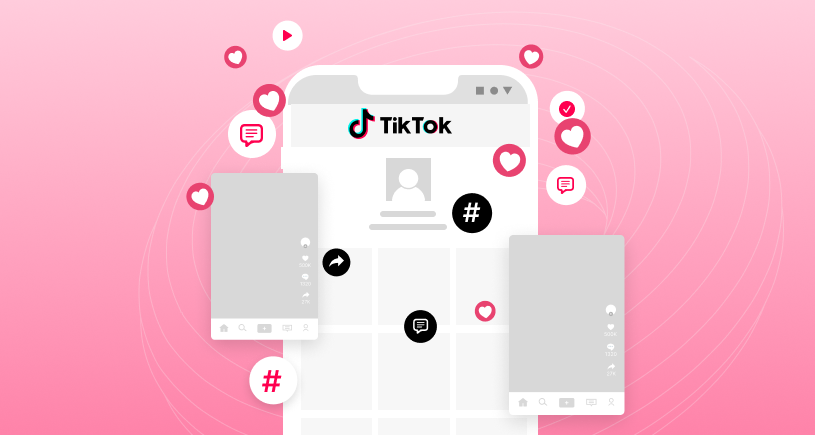
TikTok’s algorithm has multiple ranking signals, but the three most important are user interactions, video information, and account settings.
User interactions
User interactions are likely the most important ranking signal for TikTok’s algorithm. The more followers interact with the content your company’s posts, the more likely they’ll be to see your content again. The algorithm will find your content relevant to their past interactions and recommend them on their “For You” page.
For example, TikTok’s algorithm will collect data based on the videos your followers like and share, the comments they post, and their video completion rate, and find similar content to share with them.
Video information
The next ranking signal of TikTok’s algorithm is the video information in the content your followers find in the “Discover” tab. This can include sounds, captions, video effects, and trending topics in the videos your followers regularly seek out on the platform. The algorithm pays close attention to this information and will find more videos with similar information to share with them. This is why keeping up with the latest trends, using popular sounds in your videos, and following the actions of your competitors are important to help you reach more followers.
Device and account settings
The last ranking signal that TikTok pays attention to is unique from other social algorithms. Your followers’ device and account settings on their accounts can affect whether TikTok decides to prioritize your content in their profiles. Settings like country, language, device, and interest categories they choose when creating a profile are all indicators for the algorithm to tailor content in their profiles. So, establish your target audience’s country, language, and even their preferred devices to make sure TikTok’s algorithm promotes your organization’s content effectively.
Key tips for success on TikTok’s algorithm:
- Lean toward creating shorter videos. Video completion time is a major factor in TikTok’s algorithm – making short videos perform better.
- Take advantage of keywords in your captions to help TikTok show your videos to the right followers.
- Add trending hashtags and audio to your posts to ride the latest trends.
Pinterest’s algorithm

Pinterest’s algorithm works differently from other major social platforms. Pinterest mainly focuses on two things: website quality and engagement levels.
Website quality
The quality of the website and the Pinned post matters regarding how well content ranks on Pinterest. If a Pinned post links to a low-quality site or irrelevant content, it will be less likely to rank well in Pinterest’s algorithm. Make sure your company’s website is fast, user-friendly, and has high-quality content to play into Pinterest’s algorithm.
Engagement
Pinterest ranks websites by engagement, which comes in the form of Pins. More Pins mean a more reliable and popular website. Therefore, the individual post that gets Pinned will reach more followers, and other posts from that website owner will be prioritized too. The more pins your posts get, the more it gets promoted to your followers.
Key tips for success with Pinterest’s algorithm:
- Pinterest prioritizes quality, so make sure you add high-quality images and optimize your website for user experience to show Pinterest you’re worth sharing with your followers.
- Add captivating visuals to reach more followers.
- Add keywords wherever possible to give Pinterest’s algorithm context.
- Share your content with the right followers.
YouTube’s algorithm
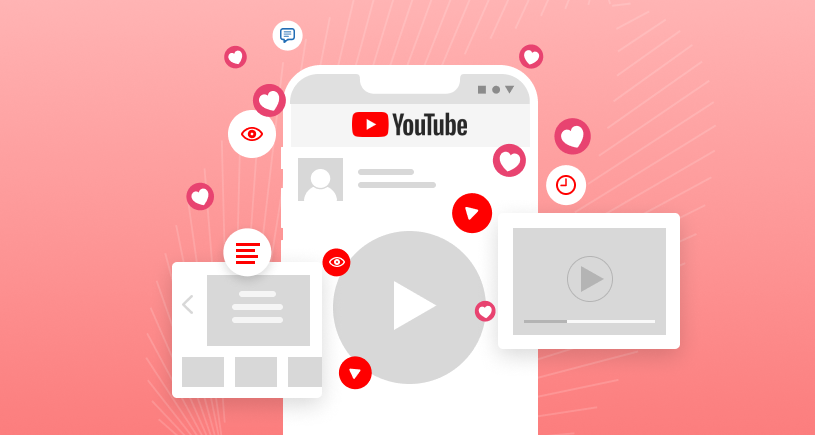
YouTube’s algorithm relies heavily on three primary ranking factors: video performance, watch history, and context.
Video performance
Video performance is the key indicator for videos that rank on YouTube’s algorithm. Simply put, the most popular videos on YouTube will rank higher than those that aren’t as popular. YouTube measures the popularity of a video based on view time, likes and dislikes, comments, shares, etc. Like LinkedIn’s algorithm, YouTube’s algorithm will measure the early engagement rates to decide whether it’s worth promoting further. Once it gets more likes, shares, and view times, it will continue to be promoted to more viewers.
Watch history
Watch history is also a critical part of YouTube’s algorithm. As viewers continue to watch videos in your industry, the algorithm will collect that data as a reference for future content. Any new videos promoted to your followers by the algorithm come from their viewing habits. Therefore, if they’ve watched multiple videos about the latest hot product offered by your company, they’ll be more likely to see more of that content suggested to them. This is why it’s a great idea to pay close attention to the trends and content your competitors are posting and create your own on-topic videos.
Context
Context plays an essential role in YouTube’s suggested videos. The suggested videos are straightforward but effective in driving more related content to suitable viewers. Depending on the content your followers watch, YouTube’s algorithm will find other commonly viewed videos. Then, the related videos will show up in their suggested videos.
Key tips for mastering YouTube’s algorithm:
- Post consistently on YouTube. Your followers and the algorithm will consider you reputable the more consistently you publish videos.
- Take advantage of your video descriptions. Fill them with high-quality keywords and optimize them for SEO to make your videos even more relevant to YouTube’s algorithm.
- Focus on relevance. YouTube’s algorithm is geared towards providing a positive user experience.
Frequently asked questions about social media algorithms
Social media algorithms organize content to reach the followers who are most likely to engage based on their recent interactions.
The common types of algorithms used in social media are popularity, relationship, recency, and content types.
Instagram uses a machine-learning algorithm that learns user behaviors and promotes similar content that will increase engagement.
Yes. TikTok uses an AI-based recommendation algorithm intended to increase user engagement.
Yes. Each social media site uses some type of algorithm to prioritize the content that reaches its followers.
Social media algorithms exist to sort out the huge amount of content posted and show followers the content they’re most likely to find engaging.
Social media algorithms can be bad because they can cause a “rabbit hole effect” when followers continue to consume content. The content can become more extreme as they continue to click through the content.
Scale your social media with Birdeye Social
Decoding social media algorithms is tough enough for a single-location business, but what if you operate a multi-location company? Birdeye Social was specifically built to help multi-location businesses scale their social media efforts so you can easily manage every profile for every location using one platform. Schedule a call with one of our experts today.

This blog post is part of our Social Media Management Guide
Originally published


